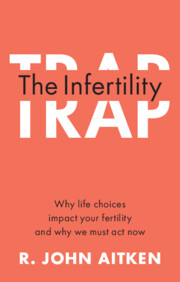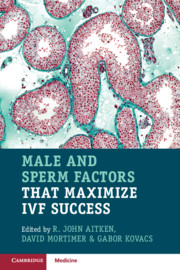31 results
Chapter 3
-
- Book:
- The Infertility Trap
- Published online:
- 05 May 2022
- Print publication:
- 05 May 2022, pp 54-131
-
- Chapter
- Export citation
Chapter 8
-
- Book:
- The Infertility Trap
- Published online:
- 05 May 2022
- Print publication:
- 05 May 2022, pp 270-304
-
- Chapter
- Export citation
Figures
-
- Book:
- The Infertility Trap
- Published online:
- 05 May 2022
- Print publication:
- 05 May 2022, pp xi-xii
-
- Chapter
- Export citation
Chapter 2
-
- Book:
- The Infertility Trap
- Published online:
- 05 May 2022
- Print publication:
- 05 May 2022, pp 11-53
-
- Chapter
- Export citation
Dedication
-
- Book:
- The Infertility Trap
- Published online:
- 05 May 2022
- Print publication:
- 05 May 2022, pp v-vi
-
- Chapter
- Export citation
Chapter 5
-
- Book:
- The Infertility Trap
- Published online:
- 05 May 2022
- Print publication:
- 05 May 2022, pp 180-202
-
- Chapter
- Export citation

The Infertility Trap
- Why Life Choices Impact your Fertility and Why We Must Act Now
-
- Published online:
- 05 May 2022
- Print publication:
- 05 May 2022
Copyright page
-
- Book:
- The Infertility Trap
- Published online:
- 05 May 2022
- Print publication:
- 05 May 2022, pp iv-iv
-
- Chapter
- Export citation
Chapter 1
-
- Book:
- The Infertility Trap
- Published online:
- 05 May 2022
- Print publication:
- 05 May 2022, pp 1-10
-
- Chapter
- Export citation
Contents
-
- Book:
- The Infertility Trap
- Published online:
- 05 May 2022
- Print publication:
- 05 May 2022, pp vii-x
-
- Chapter
- Export citation
Chapter 6
-
- Book:
- The Infertility Trap
- Published online:
- 05 May 2022
- Print publication:
- 05 May 2022, pp 203-237
-
- Chapter
- Export citation
Chapter 7
-
- Book:
- The Infertility Trap
- Published online:
- 05 May 2022
- Print publication:
- 05 May 2022, pp 238-269
-
- Chapter
- Export citation
Foreword
-
- Book:
- The Infertility Trap
- Published online:
- 05 May 2022
- Print publication:
- 05 May 2022, pp xiii-xvi
-
- Chapter
- Export citation
Index
-
- Book:
- The Infertility Trap
- Published online:
- 05 May 2022
- Print publication:
- 05 May 2022, pp 331-336
-
- Chapter
- Export citation
Chapter 4
-
- Book:
- The Infertility Trap
- Published online:
- 05 May 2022
- Print publication:
- 05 May 2022, pp 132-179
-
- Chapter
- Export citation
Chapter 9
-
- Book:
- The Infertility Trap
- Published online:
- 05 May 2022
- Print publication:
- 05 May 2022, pp 305-329
-
- Chapter
- Export citation
Acknowledgements
-
- Book:
- The Infertility Trap
- Published online:
- 05 May 2022
- Print publication:
- 05 May 2022, pp 330-330
-
- Chapter
- Export citation
Introduction
-
-
- Book:
- Manual of Sperm Function Testing in Human Assisted Reproduction
- Published online:
- 05 April 2021
- Print publication:
- 15 April 2021, pp 1-5
-
- Chapter
- Export citation
Chapter 5 - Life and Death in the Germ Line
- from Section 2 - Reproductive Biology and Cryobiology
-
-
- Book:
- Fertility Preservation
- Published online:
- 27 March 2021
- Print publication:
- 08 April 2021, pp 35-48
-
- Chapter
- Export citation

Male and Sperm Factors that Maximize IVF Success
-
- Published online:
- 24 May 2020
- Print publication:
- 30 April 2020

